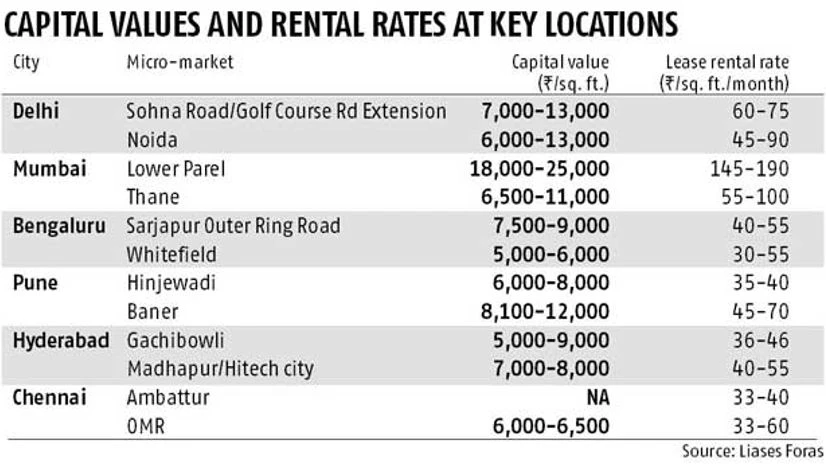Real estate consultancy JLL India recently announced that Bengaluru saw the highest leasing activity within the Asia-Pacific region (above 200,000 square metres) while Delhi-NCR recorded the third-highest number (above 100,000 square metres) in the first quarter of 2016. It seems the commercial real estate segment (office space), which had been in the doldrums between 2008 and 2013, is witnessing a recovery, driven by higher demand from IT-ITES, e-commerce, financial companies and the service sector at large. The segment offers attractive opportunities to deep-pocketed investors.
Capital values are relatively low in most cities at present and rental rates are also not exorbitant (see table), making investment in commercial property an attractive proposition. Lack of opportunities within the residential segment is also propelling investors towards commercial real estate. "Current price levels are way beyond what people can afford, which is why absorption is not improving and inventory levels remain high in most cities. That is why commercial real estate is now the market favourite," says Pankaj Kapoor, managing director, Liases Foras.
Attractive and predictable rentals: Commercial real estate is well suited for high net worth individuals (HNIs) looking to earn steady cash flows over the long term. "The annual rental yield from this segment can range from 9-11 per cent, whereas one can't expect a return of more than 2-3.5 per cent a year from residential property," says Anuj Puri, chairman and country head, JLL India.
Predictability of rental flows is another attraction. "If you have invested in a Grade- A office space and own a large floor area, you could attract quality tenants, including Fortune 500 companies. Such tenants come with long-term lease agreements of five years or more, which lend predictability to rentals flows," says Prateek Pant, co-founder and head of products and solutions, Sanctum Wealth Management.
The REITs opportunity: Real estate investment trusts (Reits), which are likely to become operational in India soon, are expected to result in large investment flows into the commercial segment. "Many of the tenanted Grade-A commercial buildings will be transferred into REIT structures. This will create a vibrant secondary market," says Pant.
A word of caution: Investors foraying into this segment should be aware of its potential risks. The first of these is investing at the wrong valuation. "You should get a rental yield of at least 10 per cent or above in today's market," says Kapoor. Another risk lies in the current tenants vacating the building. If they do so, there is always a question mark on how soon the building will be reoccupied, and at what rental yield. If the investor has taken a loan, his cash woes tend to compound with each passing month.
Only investors with deep pockets should think of investing in commercial real estate. To be able to attract a high grade tenant, you need to invest in at least 5,000-8,000 sq. ft. of space. So, capital outlay typically runs into crores in this segment.
Look for the right location: "Choose a location with sound demand-supply dynamics. Avoid those where vacancy rates are high," says Puri. Standalone buildings on the periphery of the city should be avoided, as commercial properties tend to benefit from cluster effect. There should be a large catchment of residential population within a travel time of 40-45 minutes. Proper connectivity, accessibility to public transportation, and quality infrastructure in the area are other factors to which you should pay heed. Investing in a city witnessing brisk job growth also results in attractive returns.
The stage at which you invest in a commercial property also determines your level of risk. Invest at the development stage and you will be subject to what is known as development risk. This refers to the danger that the developer may not complete the building on time, or in the worst case, not develop it at all. "If you enter at the under-construction stage, make sure the developer has achieved timelines at earlier stages," says Ajay Rakheja, chief executive officer, Creindia.com. Adds Pant: "Today, the safest option is to invest in a pre-tenanted property, where you know who the developer and the tenants are, and the duration of the lease agreements that have been signed." When investing in a pre-tenanted building, look at the quality of tenants. The presence of high-quality tenants creates a positive eco-system that attracts more such tenants.
Don't fall prey to assured returns schemes: Today, when developers have to pay an interest rate of above 18 per cent a year on loans, this is their way of getting you to subsidise their cost of project financing. "Such schemes are risky and many have lost money. Whatever builders may write in the agreement, there is always the risk that they may go back on their promises," warns Kapoor.

)
